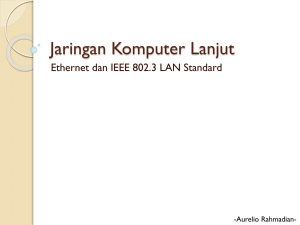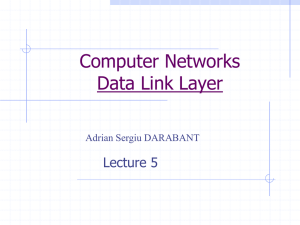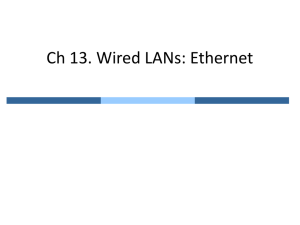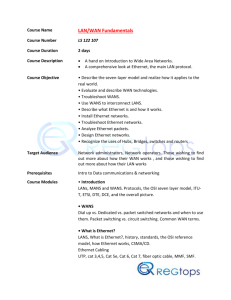Ch. 9 - Ethernet - Information Systems Technology
advertisement
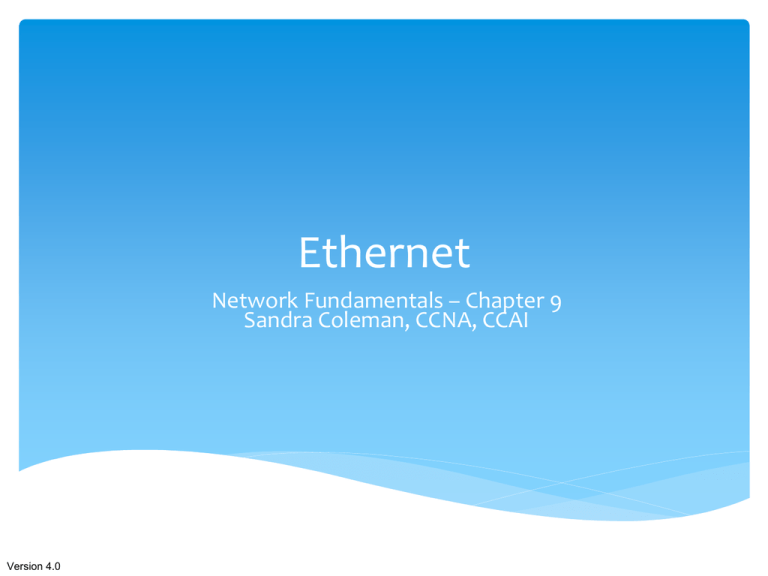
Ethernet Network Fundamentals – Chapter 9 Sandra Coleman, CCNA, CCAI Version 4.0 Objectives Identify the basic characteristics of network media used in Ethernet. Describe the physical and data link features of Ethernet. Describe the function and characteristics of the media access control method used by Ethernet protocol. Explain the importance of Layer 2 addressing used for data transmission and determine how the different types of addressing impacts network operation and performance. Compare and contrast the application and benefits of using Ethernet switches in a LAN as opposed to using hubs. Explain the ARP process. Characteristics of Network Media used in Ethernet Alohanet – 1970 – digital radio network to connect Hawaiin islands. 1st LAN – Robert Metcalf – Xerox – 30 yrs. Ago DIX (Digital Equipment, Intel, Xerox) – released stds. in 1980 IEEE 802.x – 1985 Ethernet operates at Layers 1 & 2 of OSI Model (Physical & Data Link) Ethernet operates at Network Access layer of TCP/IP model Physical and Data Link Features of Ethernet Layer 1 – involves signals, bit streams that travel on the media, various topologies Layer 2 – MAC sublayer – concerned w/physical components (802.3) LLC sublayer – (802.2) independent of physical equip. Concerned with upper layer transitions Physical and Data Link Features of Ethernet Know the IEEE numbers for Layer 1 & 2 protocols Physical and Data Link Features of Ethernet Logic Link Control – Connecting the Upper Layers IEEE 802.2 standard is represented here Physical and Data Link Features of Ethernet Media Access Control (MAC) Characteristics of Network Media used in Ethernet Success of Ethernet is because of: simplicity/ease of maintenance, ability to adapt new technologies, reliability, and lower cost to install and upgrade Physical and Data Link Features of Ethernet 2 most common types of media are copper UTP and optical fiber. Characteristics of Network Media used in Ethernet Migration from hubs to switches to increase throughput while minimizing collisions Each port on a switch is a collision domain Layer 2 Addressing and Its Impact on Network Operation and Performance DATA field contains the layer 3 (network layer) packet Layer 2 Addressing (MAC) The Ethernet MAC Address MAC Address specifications Copied to RAM from ROM during POST (startup) 6 bytes (12 hex digits) long (3 bytes OUI, 3 bytes vendor assigned) Hexadecimal Numbering system Base 16 – 0-9, A-F.. Another layer of addressing MAC – used locally in the frame, layer 2 address IP – used to cross a WAN in a packet, layer 3 address Addressing IP addresses NEVER change in a packet (layer 3) MAC addresses DO change within a frame (layer 2) If a device doesn’t know the MAC address for an IP address, it will broadcast an ARP request for this information. Unicast – delivers a packet to ONE single destination host Broadcast – delivers a packet to all hosts on a single broadcast domain Multicast – delivers a packet to a group of hosts MAC in Ethernet All devices have guaranteed access to the medium, but no prioritized claim on it. Explain CSMA/CD. Carrier Sense Multiple Access w/Collision Detection Random delay (backoff algorithm) is used to try to help prevent another collision. First expired timer gets to transmit data first. Once a collision has occurred, devices return to listen before transmitting mode – THIS DECREASES network performance! Devices DO NOT interrupt others that are in the process of sending data! Ethernet Timing Every device that data travels (propagates) through adds delay (latency) because of the error checking, decision making involved. This delay will actually cause some devices to transmit thinking there is NO signal on the wire, hence; collisions! Interframe spacing Gives the media time to stabilize between frames. Allows slow devices time to process a frame and prepare for the next frame. All devices are required to wait 96 microseconds before transmitting again. Overview of physical layer Legacy Ethernet – Using Hubs Created LOTS of collisions which will decrease network performance Not scalable – just results in larger collision domains! Increased latency Ethernet – Using Switches Each port is its on collision domain; full bandwidth available to that port – full duplexing capabilities – virtually collision FREE! Switch will isolate segments and limit collisions! Address Resolution Protocol (ARP) Process Purpose: resolve IPv4 addresses to MAC addresses Maintained dynamically by monitoring traffic that occurs on that segment of the network or by broadcasting an ARP request packets with the desired IP address, looking for the MAC address. Receiving device responds by sending an ARP reply back as a unicast frame with its MAC address. It can then be added to the ARP table. YEAH… Only 2 more chapters!!! -Study Guide – Do this NOW and show me... - Pg. 232-233 Matching - Pg. 234-235 – Multiple Choice - Pg. 238 – Matching - Pg. 239-240 – Multiple Choice -Discuss online Test – take it before next class, open book. Will count as a test grade. -Labs…None




